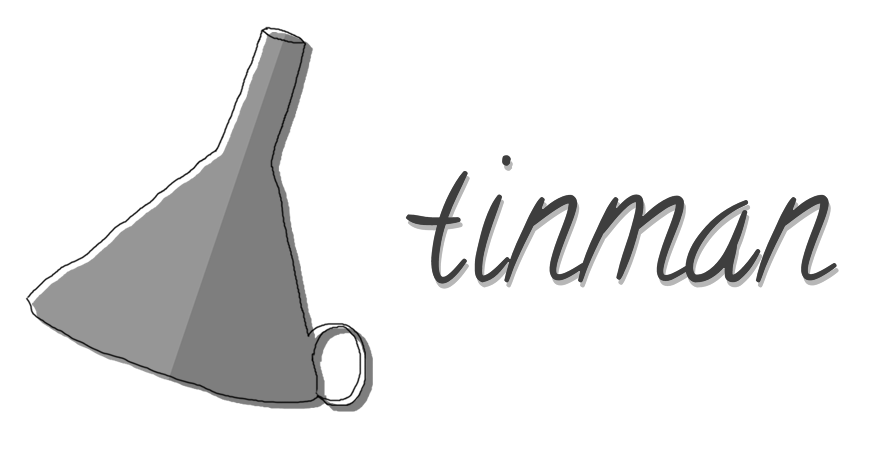
A tiny static-ready blog engine based on the toto library. The shiniest blog engine in Oz!
npm install -g tinman
What is Tinman?
A basic tinman blog looks like this:
example
├── articles
│ └── 2014-06-22-hello-world.md
└── public
└── style.css
Some features include:
- Generate a simple blog with nothing but a few markdown files
- Serve anything static by placing it in the public/ directory
- A comprehensive CLI to handle best-practices for you
- Customize templates to your heart's desire
- Run your blog as web server or export it as a static site
- Add any CSS or JavaScript and have it just work
What do I get?
Tinman generates a page for each article, and an index page listing your
articles (sorted by filename). Naming your articles YYYY-MM-DD-my-title.md
will sort them such that the most recent article is listed first. It
will also set the article's date property for you.
Usage
Create a new blog
$ tinman createBlog title: myblog Your blog is ready! To get started: cd myblog/ tinman server $ tinman create myblog # Generate example templates to play with as well $ tinman create myblog --with-templatesGenerate a new article
$ tinman newTitle: This is my first blog post Article generated at: articles/2014-07-05-this-is-my-first-blog-post.mdRun your blog on a local webserver
$ tinman serverServer listening on port 3000... $ tinman server --port 1337Server listening on port 1337...Build your blog as a static site
$ tinman build Blog successfully built to: build/ $ tinman build --output-dir www Blog successfully built to: wwwWriting Articles
Articles are written in Markdown and use YAML Front Matter to set various options.
---title: Hello, World!date: 2014-06-22--- Once upon a time...This article will be accessible at the url /hello-world by default
(based on the article's title). You can customize this option by either:
- Setting the
slugproperty, making the article accessible at/your-slug-here - Setting the
routeproperty, and completely overriding the slug (i.e.route: /2014/06/24/musings/my-article
You can include any custom options you'd like (i.e. color: red) in
your YAML Front Matter, and recall it from a custom template.
Templates
Tinman uses EJS templates and includes the following:
- article.ejs for templating an individual article
- index.ejs for the article index page
- layout.ejs which wraps around the other two and renders asset tags
To customize these templates, pass the --with-templates option to
tinman create:
$ tinman create myblog --with-templates Your blog is ready! To get started: cd myblog/ tinman server $ tree myblogmyblog├── articles│ └── 2014-06-22-hello-world.md├── public│ └── style.css├── templates│ ├── article.ejs│ ├── index.ejs│ └── layout.ejs└── tinman.jsonBeyond the articles directory and sample stylesheet, the
--with-templates option creates a templates directory and a
tinman.json file, instructing Tinman to use these templates instead of the
ones built into it.
What data do my templates receive?
The article template receives all properties of the article as defined in
the YAML Front Matter. The content of the article is stored as body. Some
extra fields include:
- summary: the first paragraph of the rendered article
- filename: self-explanatory
- date: the date either extracted from the filename or from the
dateproperty of the article's Front Matter
The index template has access to the array articles, which holds
every article in your blog.
The layout template receives a body, which contains the rendered HTML of
the page it contains (either an article page or the index). This template also
has access to two strings, stylesheets and scripts, which store the CSS/JS
resource tags generated automatically based on the contents of your public
directory.
Plugins
Plugins are small helper modules that all templates can access, allowing you to add extra functionality to your blog. An example plugin may look like the following:
// hello.jsmodule { return "Hello, " + name + "!";};Which you can then access in any template like so:
<%= plugins.greeting("Jordan") %>How do I load a plugin?
In order for Tinman to appropriately load your plugins, you need to
populate the plugins object in your tinman.json file. You'll notice
this file is generated for you automatically when you create a new blog
using the --with-templates option.
Each entry in plugins consists of two items, the identifier that your
template will be able to call (i.e. plugins.greeting) and a require
string (just as you would pass to require() in node).
"plugins": "ms": "ms" // load "ms" from node_modules/ "other": "./blah" // load "blah.js" locally as "other" Just remember to npm install any external modules before trying to use
them.
Static Files
Tinman will automatically copy static assets (images, stylesheets,
javascripts) from the "public" directory (default: public/).
For instance, you can write the following to public/css/colors/main.css:
And access it like so:
You can follow the same pattern for including images in your articles, or even serving static HTML documents.
In addition, Tinman scans for javascripts (*.js) and stylesheets (*.css)
and automatically generates resource tags in the layout template
(layout.ejs is sent both a scripts and stylesheets string). You do
not need to edit any templates after writing javascripts or stylesheets.
-- MIT Licensed